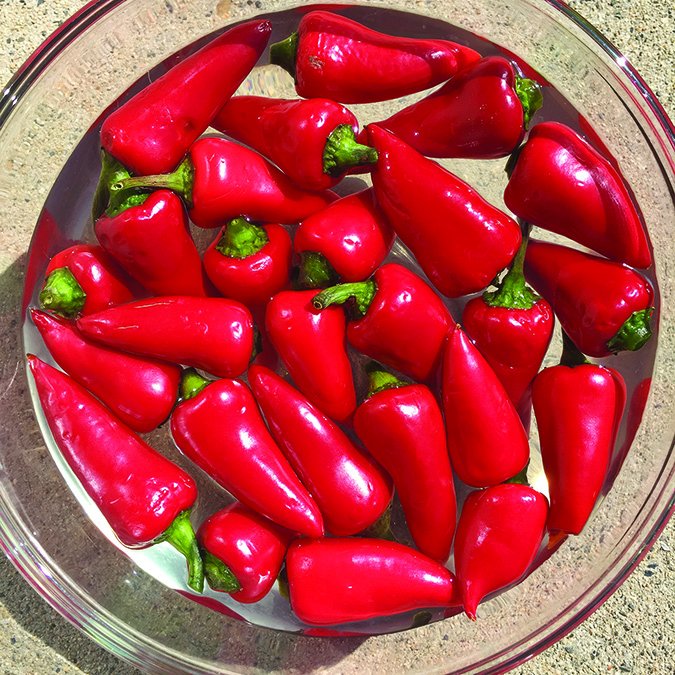[Updated August 22, 2018]
Cayenne or chili pepper – the spice that gives Mexican and Sichuan food its heat – is an important medicinal plant. Not only is it Herb of the Year for 2016, it’s good for dogs!
Since 1985, the International Herb Association has announced its Herb of the Year during National Herb Week, which this year is May 1 through 7. The IHA has just published Capsicum: Herb of the Year 2016, a book that reviews chili peppers and their growing conditions and uses, and the organization helps garden centers and herb farms promote its featured plant.
Cayenne (Capsicum annuum) and other members of the Capsicum family are known as chili, chilli, chille, or chile peppers. They belong to the nightshade family, which includes potatoes, tomatoes, eggplant, bell peppers, paprika, pimento, tomatillos, and tobacco.
Native to Central and South America, where they have been cultivated for more than 6,000 years, Capsicum peppers were brought to Europe by Christopher Columbus, whose physician recognized their medicinal benefits. Portuguese explorers continued the trend, and soon hot peppers were grown around the world. Today’s popular varieties include (from mild to hottest) Anaheim, jalapeno, serrano, cayenne, tabasco, Thai, habanero, and ghost peppers.
Rich in vitamins C and A, cayenne also supplies vitamins B3 (niacin), B2 (riboflavin), and B6 (pyridoxine), the minerals iron, copper, and potassium, plus flavonoids and other micronutrients.
Cayenne’s unique ingredient is the alkaloid compound capsaicin (pronounced cap-SAY-sin), which gives hot peppers their heat.
How hot is hot? In 1912, Wilbur Scoville, an American pharmacist, created a test to measure the heat of chili peppers. Now called the Scoville scale, its SHU (Scoville Heat Unit) ratings range from zero (bell peppers) to 30,000 to 50,000 (cayenne), 100,000 to 300,000 (habanero and Scotch bonnet peppers), and up to 2 million for the world’s hottest peppers. Today their heat is measured by High Performance Liquid Chromatography, or HPLC, but the Scoville Heat Units remain popular.
Medicinally, chili peppers are added to herbal formulas in small amounts as a catalyst, a substance that causes or accelerates a chemical reaction without itself being affected. In oral supplements or when added to food, cayenne speeds reactions in the digestive and circulatory systems. Applied topically, it is a rubefacient, which means that it increases circulation to the skin, nerves, and joints, opening subcutaneous capillaries and acting as an analgesic. Wherever applied, cayenne improves the body’s ability to absorb nutrients, fight infection, alleviate pain, and reduce inflammation.
Can Dogs Eat Cayenne?
The key word in any application of medicinal herbs is moderation. This is especially important with cayenne because too much applied topically can damage the skin or, when swallowed, cause severe digestive pain.
Cayenne made headlines in Seattle three years ago when a property manager sprinkled cayenne pepper around her apartment complex, hoping to repel resident dogs whose owners left their waste behind. At least one dog was injured as a result, prompting demands for legal action. Charges of animal cruelty were not filed by the county’s prosecuting attorney because while exposure to cayenne can be painful, it isn’t fatal and doesn’t cause lasting damage. The dog received veterinary treatment and recovered, the property manager apologized, and pet owners agreed to clean up after their dogs.
Capsaicin is the main ingredient in self-defense sprays designed to repel aggressive dogs, bears, coyotes, and other animals. An Internet search will display a variety of sprays and testimonials about their effectiveness. Commercial pepper sprays use oleoresin capsicum or chili oleoresin, an extremely hot pepper extract. Pepper sprays are considered weapons if used against humans, and regulations regarding their legality vary by state according to the products’ strength and size. In some cases, such as when misused by law enforcement officials, pepper sprays have been fatal.
While the taste of pepper doesn’t always deter dogs, less concentrated sprays may prevent Fido from licking and chewing pillows, plants, shoes, or furniture. One popular do-it-yourself repellent spray posted on VetInfo.com combines 1 part cayenne powder with 10 parts water in a spray bottle. “Shake up the mixture to evenly combine the two,” says the instruction page. “Spray just a few sprays of the mixture on the surfaces of the furniture that you’re interested in protecting and in the area surrounding it.”
Cayenne is also recommended as a garden insect, ant, and rodent repellent.
Because cayenne irritates mucous membranes, be careful to avoid your dog’s eyes, nose, genitals, and rectum whenever spraying or applying this herb.
Cayenne Helps Dogs’ Heart Health and Digestion
Stephen S. Nagy

Can cayenne stop a heart attack? For hundreds of years, herbalists have made this claim, and it appears to be true. Dr. John Christopher, a 20th century American herbalist, used cayenne so often for this purpose that he and his followers made cayenne a routine treatment for heart disease.
As Candace Hunter and Sue Sierralupé wrote in their book Chili Pepper: Naturally Hot Herbal Medicine, “Chili peppers may help stop a crisis in progress. We have historical data to suggest a goodly dose of chili powder swallowed amidst a heart attack can stop the crisis, though we don’t currently have scientific studies to support that. What we do know is chilies can assist the body in healing afterward. Heart surgery patients who experience low circulation, lack of energy, and listlessness are strengthened and invigorated by a daily dose of cayenne pepper in capsule form.”
According to Randy Kidd, DVM, PhD, in his article “Promoting Canine Cardiovascular Health” (WDJ February 2005), “Cayenne is probably the most useful of the systemic stimulants, regulating blood flow and equalizing and strengthening the heart, arteries, capillaries, and nerves. Cayenne is a general tonic and is specific for the circulatory and digestive systems. It has the ability to balance blood pressure, correcting it to a normal range.”
As Dr. Kidd explained, cayenne can be used any time an animal is debilitated, whenever the circulation is stagnant or there is congestion in the body, and whenever there is a lack of energy or vitality. Cayenne is also an outstanding carrier herb, helping in the transport of other herbs and medications to various parts of the body, especially to the heart, stomach, and brain.
Canine heart disease can cause lethargy, weakness, vomiting, a chronic cough, shortness of breath, lameness, and a rapid pulse, all of which may improve when cayenne is added to a dog’s food. Cayenne’s warming effect spreads throughout the body, even to an animal’s extremities, warming a dog’s cold paws and improving the health of veins and capillaries.
In the digestive tract, cayenne improves the body’s absorption of nutrients while reducing gas, flatulence, diarrhea, constipation, and other uncomfortable symptoms. Years ago doctors warned human ulcer patients to avoid hot, spicy foods, but more recent research shows that chili peppers can actually help heal ulcers.
Cayenne is available in capsules, tinctures (liquid extracts), and as the familiar culinary powder. Start with a small amount, such as a pinch of powder or a drop of tincture hidden in your dog’s food or in a capsule that can be hidden in food; two-part gelatin capsules are sold in natural food markets and online. To help prevent digestive discomfort, feed cayenne with a full meal, not on an empty stomach.
Over a period of days or weeks, gradually increase the dose according to your dog’s weight and tolerance. If purchasing cayenne capsules, look for products with a Scoville Heat Unit rating of 30,000 to 40,000, or try Nature’s Way Capsicool controlled-heat cayenne or Solaray’s Cool Cayenne, both of which are advertised as gentle to the stomach. If the recommended dose for adult humans is 2 capsules per day, work up to 1 capsule for dogs weighing 50 to 60 pounds, or, with the help of empty 2-part gel caps, feed half a capsule to dogs weighing 25 to 30 pounds or one-fourth of a capsule to dogs weighing 10 to 15 pounds.
Approximate measurements should work well because individual responses vary and sensitivity to cayenne decreases with daily exposure. If your dog shows signs of discomfort, simply reduce the amount.
You may not have to hide cayenne to get your dog to swallow it, for some dogs are chili heads! Seamus, my husband’s Cairn Terrier, is famous for his enthused vocalizations when he’s offered anything containing hot sauce or cayenne.
Cayenne Topical Treatment for Dogs
It sounds counterintuitive, but cayenne can be an effective first-aid treatment for cuts, scrapes, bites, bleeding nails, mouth lacerations, and other injuries. It is a natural styptic, which stops bleeding on contact, and an analgesic, which stops pain.
When she was a child, a friend was bitten on the leg by her grandmother’s horse. “My grandmother hauled me back to the house,” she says, “filled her hand with cayenne powder and held it against the wound. That hurt for a second or two, but then it stopped bleeding and stopped hurting. The bite was never infected, and it healed in record time without a scar.”
Herbalist Alicia North of Cornwall, Connecticut, has a similar story. Several years ago her cousin snipped the tip of her 14-year-old Terrier’s ear while trimming his hair. “Jack had been bleeding for 10 minutes when she called,” says North, “and none of the remedies she had tried made any difference. She was frantic and without a car so she wanted me to take them to the vet.”
North asked her cousin whether she had any cayenne pepper and then told her to apply it to the cut on Jack’s ear. “She was skeptical and thought that it wouldn’t work and was afraid it would hurt him,” says North. “I assured her that it would help, so she reluctantly agreed and we hung up so she could apply it. Moments later she called back shouting, ‘It worked! I’m so relieved! I thought he might bleed to death. Who knew that spices in my cabinet could be used for anything but cooking?’
“Of course, I knew,” says North, “and I was happy she got such instantaneous results!”
Aches and pains
Some of the most popular treatments for human joint pain and arthritis contain capsaicin.
As the Arthritis Foundation explains on its website:
“Applied as a topical cream, gel, or patch, capsaicin works by depleting the amount of a neurotransmitter called substance P that sends pain messages to the brain. For the first couple of weeks of use, it may cause burning or stinging as substance P is released and ultimately depleted; it must be used regularly to keep substance P from building up again. Many studies have shown that capsaicin effectively reduces pain from osteoarthritis, rheumatoid arthritis, and fibromyalgia. In a 2010 German study, joint pain decreased nearly 50 percent after three weeks’ use of 0.05 percent capsaicin cream.
“Most capsaicin products – such as Zostrix, Zostrix HP, Capzasin-P and others – contain between 0.025 to 0.075 percent concentrations. Apply regularly three times daily.”
Make Your Own Cayenne Liniment
Dogs can enjoy similar results from topical products containing capsaicin. Consider making your own liniment to warm and relax joints and muscles, increase circulation, relieve inflammation, improve flexibility, and speed healing. Traditional recipes combine skin-warming ingredients and therapeutic herbs with cider vinegar.
In a glass jar, combine:
1 pint (2 cups) apple cider vinegar
1 teaspoon powdered cayenne pepper
4 tablespoons dried (or ¼ cup fresh) rosemary
2 tablespoons dried (or 1/8 cup fresh) comfrey leaf or root that has been cut or broken into small pieces
Cover and let stand at room temperature, shaking daily, for a week or longer. Strain before using.
Massage this liniment into tight muscles, bruises, or sore joints, or simply soak a cloth or bandage and hold it on the affected area for as long as possible. You may want to wear latex or vinyl gloves while applying it. Keep this liniment away from eyes and mucous membranes.
Cayenne can be especially helpful in the treatment of pain following surgery, leg amputation, or similar traumas. Taken with food, cayenne increases circulation and promotes tissue regeneration, and applied topically, it helps reduce pain and stimulate healing. According to some reports, human patients with phantom limb pain have been helped by cayenne, as have human and canine patients with nerve damage caused by accident or injury.
Grow Your Own Peppers!
Cayenne and other peppers make attractive garden plants and can be colorful house plants. Most seed catalogs carry a variety of peppers and most garden stores and nurseries offer young plants that transplant easily. Peppers prefer full sun or sun with shade, and overnight temperatures should remain above 55° F (13° C) so that plants produce fruit.
Make Your Own Cayenne Tinctures
You can make your own custom-dose cayenne capsules by partially filling two-part gelatin capsules with cayenne powder. Herb supply companies sell capsule-filling kits to simplify the process.
Make your own cayenne tincture by filling a one-pint or one-cup glass jar with loosely packed fresh cayenne peppers (for best results, cut or chop the peppers as you fill the jar) or loosely packed crushed or broken dried peppers, then add 80-proof vodka or a similar distilled alcohol to fill the jar. Close the lid and leave the jar in a warm but shady location, shaking it every few days for four to six weeks.
When ready to use, strain the tincture through cheesecloth or muslin and pour it into dropper bottles. All the supplies you need are available at natural markets, herbal supply stores, and online. Alcohol tinctures keep for years if stored away from heat and light.
Make Your Own Lactofermented Hot Sauce (AKA Sriracha)
By making a hot sauce, you and your dog can further enjoy the benefits of chili peppers – with just about anything! Start with:
1 pound Fresno or other fresh hot peppers
4 cloves garlic
2 teaspoons salt
2 tablespoons honey or maple syrup
4 tablespoons liquid whey (the clear liquid that separates from live-culture yogurt when you cut it with a spoon and leave it in the refrigerator).
Combine these ingredients in a food processor or blender, or mince the peppers by hand and combine with the other ingredients. Spoon the chili mixture into a glass jar, leaving 1 inch of head space, cover, and let stand at room temperature for 3 to 5 days (longer if the kitchen is cool, less in hot weather).
Transfer to the fridge until ready to use, then set a fine-mesh strainer over a mixing bowl and press the fermented chili through it, or sieve the sauce through a food mill. Pour the strained sauce into a jar or bottle and store in the refrigerator, where it will keep for months. Use in moderation to add warmth and spice to your meals. The taste is uniquely complex and more flavorful than that of vinegar-based sauces. Try adding a drop or two to your dog’s food or use it in place of pepper tincture in two-part gelatin capsules.
Spicy Homeopathy: Cayenne Flower Essence
No discussion of cayenne would be complete without mentioning its use in homeopathy and flower essences. Homeopathic preparations are so diluted that they contain very little of their original ingredient, making them exceptionally safe to use. Homeopathic Capsicum annuum is often prescribed at the 3x or 6x strength for those with poor circulation or who have respiratory or digestive problems. Homeopathic remedies are usually given under the tongue between meals.
Flower essences are made by placing freshly picked blossoms in crystal bowls of pure spring water and leaving them in direct sunlight for three or more hours, after which the flowers are discarded and the energized water is preserved with brandy.
According to the Flower Essence Society, “Cayenne flower essence is a wonderful catalyst whenever we are stuck and need to light a fire to move through obstacles… Cayenne essence can fire up a sluggish will, stimulating activity and movement when our life has stagnated, to move through inertia and challenging obstacles.” It is considered a treatment for apathy and depression.
Some canine massage therapists and acupuncturists incorporate flower essences into their hands-on work. Applying flower essences to a chakra or an acupressure point and then pressing, holding, massaging, or tapping the point can increase the treatment’s effectiveness. Because frequency of application makes flower essences effective, try applying a drop of cayenne flower essence to your dog’s bare skin (nose, paw pads, abdomen, and inside ears) at least twice or three times daily.
CJ Puotinen, author of The Encyclopedia of Natural Pet Care and other books, is a long-time contributor to WDJ. She lives in Montana.





